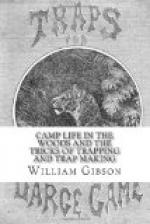[Illustration]
In addition to the various ointments used, it is well to be provided with a head-net, such as we illustrate. Nets of this kind are specially made for sportsmen, and consist of a spiral wire framework, covered with mosquito netting, and of such a size to slip easily on the head.
[Page 258] They are easily made, as our engraving would indicate.
A netting attachment for the hat is also an acquisition, especially in open woods, free from overhanging branches or dense thickets. Such a netting may be secured to the edge of the hat brim, and gathered with an elastic at the lower edge. This elastic will close snugly around the neck when in use, and at other times may be drawn above the brim and allowed to rest on top of the crown.
The portable hat brim, which we illustrate, is an article of trade in common use among sportsmen, and particularly the angler. Our engraving (a) shows the article separate. It is made of cloth, and is kept in its circular shape by a steel spring band at the circumference, between the two sides. It may be attached to any hat, and will act as a most effectual shelter to the rays of a hot sun.
[Illustration: a]
The netting above alluded to may be attached to such a brim, and applied to the edge of the hat when desired. This is shown at (b), which also indicates the manner of adjustment of the brim. Such a brim will often do good service, and may be obtained at almost any sporting emporium at trifling cost. It is portable in every sense of the word, being easily bent and packed away in the pocket.




